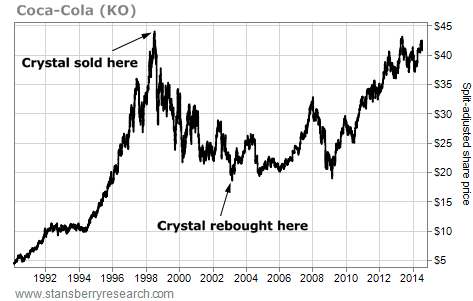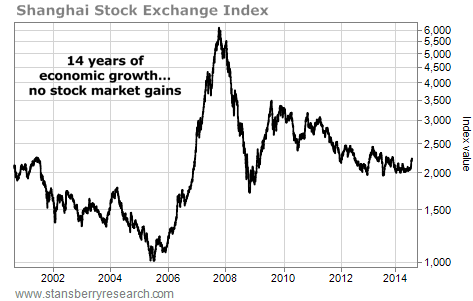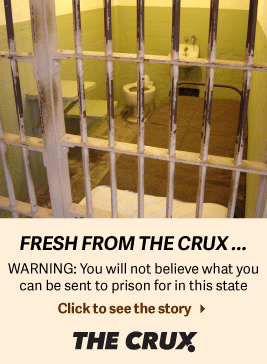| Home | About Us | Resources | Archive | Free Reports | Market Window |
The Power of Doing NothingBy
Friday, August 8, 2014
As an investor, one of the smartest things you can do is... nothing.
Billionaire investor Warren Buffett summarized this secret – the Power of Doing Nothing – with his famous mantra: "Lethargy bordering on sloth remains the cornerstone of our investment style."
In today's DailyWealth, I'll show you how this powerful secret works… and why – if you focus on the right investments – doing absolutely nothing can be a more successful strategy than perfectly timing the market.
Let's get started…
Take a look at one of our favorite capital-efficient businesses, soft-drink titan Coca-Cola (KO). As you can see in the chart below... June 1998 to March 2003, KO shares lost half their value. Conventional investing wisdom would say that – assuming you had a crystal ball – long-term KO bulls should sell in June 1998 and buy back in March 2003 when the stock bottomed out... Let's test this thesis.
Imagine two Coke investors, Crystal and Sally, both buy 20 shares of the stock on January 1, 1990 – a $1,500 investment. Both reinvest dividends for the duration of their holding periods using a dividend-reinvestment plan (DRIP). That means instead of receiving a regular dividend check in the mail, the company pays them in stock. This allows Crystal and Sally to compound their investments by receiving dividends on their dividends. Eventually, this becomes like a snowball rolling down a hill – compounding their original investment exponentially.
Crystal also has a crystal ball… which tells her to sell in June 1998, near the market's peak. By that time, she has accumulated 180 shares (three stock splits and 20 shares accumulated through her DRIP). Crystal walks away with more than $15,000.
Five years later, Crystal's ball springs to life and informs her Coke is at a market low. Time to get back in. Crystal raises $7,300 and buys back those 180 shares she sold in 1998. She timed the market perfectly. She sold high and re-bought low.
 In total, Crystal made two separate KO investments totaling $8,800 ($1,500 in 1990 and $7,300 at the stock's bottom). By June 30, 2014, Crystal's two investments (totaling $8,800) have turned into $36,000. She's up 309%. She's a genius.
Sally is not a genius. Nor is she clairvoyant. In fact, she oozes sloth-like laziness. She made her one $1,500 investment and didn't open her brokerage statements after that. It's not even clear she remembered she owned the stock when it was tanking in 1998-2003. She didn't do squat.
Fast forward to June 30, 2014. Sally's one investment (the original $1,500) is worth $22,000. She's up 1,333% doing nothing. (And for the record, had Sally set up a 25% trailing stop... she never would have stopped out, thanks to the dividends received.)
But it gets better…
As of June 30, Crystal has 489 KO shares, and Sally has 523 shares. So when KO cuts its next dividend check, Sally is going to get dividends on 34 extra shares. And Sally's "free share" advantage will snowball exponentially with each new ex-dividend date.
Now, at this point, you may be crying foul, "Why wouldn't Crystal reinvest all $15,000 she took out of her first investment?" And that's fair.
But remember, that means Crystal would have to sit on that 15 grand for six years. Not reinvest in other opportunities... Not blow it in Vegas... Not buy that beach house... or a cool new bike.
(And of course, if you have a fully functioning crystal ball, this whole essay is moot. Take it to Vegas.)
The key is what the "free share" effect does to like-sized positions...
Sally enjoyed five years of free shares that Crystal missed out on. And since KO's price was depressed while Crystal was out... Sally actually got more bang for her free-share buck when those shares began rising again.
Crystal missed out on dividends worth approximately 12 additional free shares while she was out of the stock. From the time she bought back in (March 2003) through June 30, 2014, what was a 12-share advantage for Sally compounded into a 34-share advantage. Again, this advantage will widen with every dividend KO pays.
When a stock falls, a capital-efficient investor's reaction should be "great! More free shares!" If you think a high-yielding stock you love long term may fall in the short term, the last thing you should do is sell and buy back later.
There is plenty of money to be made by speculating in the market... but, for your long-term investments, it's best to forget everything you thought you knew about market timing, trading tricks, etc.
That's why this secret is so important...
Not only did Crystal pick a great stock and reinvest the dividends... but she also bought and sold at the exact right time. Despite doing all the right things and having a magical stock-picking ball at her disposal... "lethargy bordering on sloth" beat her returns. It is almost never a good idea to interrupt the compounding power of reinvested dividends.
Good investing,
Bryan Beach
Further Reading:
Chris Mayer recently told DailyWealth readers another benefit to resisting the urge to act. "It works because it keeps your worst instincts from hurting you," Chris writes. Learn more about Chris' "Coffee Can" portfolio right here.
Many investors believe that dividend stocks have entered "bubble" territory. S&A Editor in Chief Brian Hunt disagrees: "You should realize that anyone who says dividend stocks are in a bubble doesn't know his financial history." Learn why right here.
Market NotesCHINA: BIG GROWTH, SMALL RETURNS In the May 14 edition of DailyWealth, Steve debunked one of the most popular stock market myths: That big economic growth always leads to big stock returns.
Today's chart is a follow-up to that essay. It shows the lack of returns in China.
You know the China story. Over the past few decades, it has become the world's fastest-growing large economy. It has become the "workshop of the world" and a voracious consumer of natural resources.
But as you can see from the 14-year chart below, that GDP growth hasn't translated into stock market gains. The benchmark Chinese stock index has boomed and busted several times... but still sits at 2001 levels.
 |
Recent Articles
|



